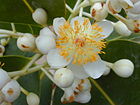Note: This is a project under development. The articles on this wiki are just being initiated and broadly incomplete. You can Help creating new pages.
Calophyllum inophyllum - Punnaga
Punnaga is a moderate sized tree with smooth and shining oppositely arranged leaves. The fruits are used to make oil. Calophyllum inophyllum usually occurs naturally all along the coast, on beaches and further inland as well.
Contents
[hide]- 1 Uses
- 2 Parts Used
- 3 Chemical Composition
- 4 Common names
- 5 Properties
- 6 Habit
- 7 Identification
- 8 List of Ayurvedic medicine in which the herb is used
- 9 Where to get the saplings
- 10 Mode of Propagation
- 11 How to plant/cultivate
- 12 Commonly seen growing in areas
- 13 Photo Gallery
- 14 References
- 15 External Links
Uses
Gastritis, Nasal bleeding, Psychiatric disorders, Diarrhea, Ulcer, Dysentery, Urinary tract infection [1]
Parts Used
Chemical Composition
Calophyllolide, a complex 5-Phcoumarin isolated from nuts, showed antiarrhythmic (as effective as quinidine), bradycardiac coronary dilator, and anticoagulant, also anti-inflammatory and antiarthritic activity. [2]
Common names
| Language | Common name |
|---|---|
| Kannada | ಹೊನ್ನೆ Honne, ಹೂಹೊನ್ನೆ Huhonne, ನಮೇರು ಮರ Nameru mara |
| Hindi | Sultanachampa, Surpunka, Undi |
| Malayalam | Ceruppuna, Ponnakum, Pouna, punna |
| Tamil | Cayantakam, Punnagam, Punnai-maram |
| Telugu | Naameru, Nameru, Ponna, Ponna chettu |
| Marathi | Punnaga, Undi |
| Gujarathi | NA |
| Punjabi | NA |
| Kashmiri | NA |
| Sanskrit | Namaeruak, Panchakaeshera, Punnaga |
| English | Alexanrian laurel |
Properties
Reference: Dravya - Substance, Rasa - Taste, Guna - Qualities, Veerya - Potency, Vipaka - Post-digesion effect, Karma - Pharmacological activity, Prabhava - Therepeutics.
Dravya
Rasa
Madhura (Sweet), Kashaya (Astringent)
Guna
Laghu (Light), Rooksha (Dry)
Veerya
Sheeta (cold)
Vipaka
Madhura (Sweet)
Karma
Pitta, Kapha
Prabhava
Habit
Identification
Leaf
| Kind | Shape | Feature |
|---|---|---|
| Simple | Opposite | Leaves broadly elliptic-oblong or obovate, cuneate to rounded at base, slightly recurved and margined. |
Flower
| Type | Size | Color and composition | Stamen | More information |
|---|---|---|---|---|
| Bisexual | Axillary racemes | White | Flowers polygamous, 2-2.5 cm across, white, fragrant. |
Fruit
| Type | Size | Mass | Appearance | Seeds | More information |
|---|---|---|---|---|---|
| Drupe | 2.5-5 x 2.5-4 cm | Smooth; stone subglobose, ca 2 cm across. | {{{6}}} |
Other features
List of Ayurvedic medicine in which the herb is used
Where to get the saplings
Mode of Propagation
How to plant/cultivate
Season to grow
Soil type
Propagation
Commonly seen growing in areas
Photo Gallery
References
External Links
- Ayurvedic Herbs known to be helpful to treat Gastritis
- Ayurvedic Herbs known to be helpful to treat Nasal bleeding
- Ayurvedic Herbs known to be helpful to treat Psychiatric disorders
- Ayurvedic Herbs known to be helpful to treat Diarrhea
- Ayurvedic Herbs known to be helpful to treat Ulcer
- Ayurvedic Herbs known to be helpful to treat Dysentery
- Ayurvedic Herbs known to be helpful to treat Urinary tract infection
- Herbs with Seeds used in medicine
- Herbs with Bark used in medicine
- Herbs with Oil used in medicine
- Herbs with common name in Kannada
- Herbs with common name in Hindi
- Herbs with common name in Malayalam
- Herbs with common name in Tamil
- Herbs with common name in Telugu
- Herbs with common name in Marathi
- Herbs with common name in Sanskrit
- Herbs with common name in English
- Habit - Tree
- Index of Plants which can be propagated by Seeds
- Index of Plants which can be propagated by Cuttings
- Herbs that are commonly seen in the region of Tropical area
- Herbs that are commonly seen in the region of Coastal area
- Herbs
- Tree
- Ayurvedic herbs that don't have seed photos
- Clusiaceae







